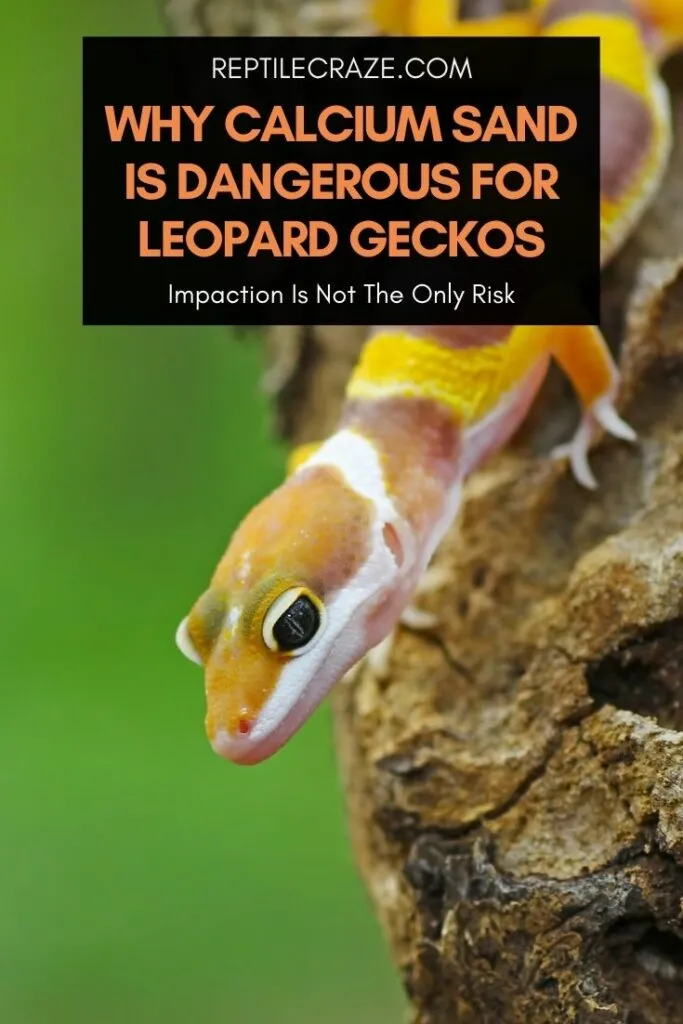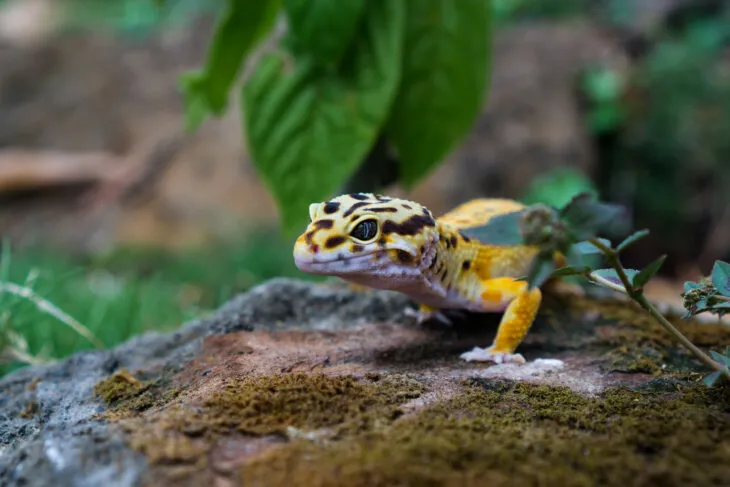
When it comes to leopard gecko substrates, there’s a ton of (sometimes contradictory) information out there! Some reptile owners suggest that sand, including calcium sand, is a great substrate option for leopard geckos because it mimics their natural desert environment and provides a source of easy-to-digest calcium. But is this true?
Calcium sand isn’t a good choice of substrate for your leopard gecko. In fact, calcium sand poses many risks to your leo’s health, including impaction risk, other digestive problems, and irritation from dust. Along with these potential risks, calcium sand doesn’t provide added benefits over known safer substrates.
So, what about calcium sand causes these issues and why? Is sand really a natural substrate for leopard geckos, and is using sand ever an acceptable option? What are some alternative substrates that can keep your leopard gecko safe and healthy while maintaining a more “natural” look? Well, keep reading to find out!
Table of Contents
Why Calcium Sand Is Bad For Leopard Geckos
Calcium sand consists mainly of calcium carbonate (about 95%), the principal mineral component of limestone.
Historically, calcium carbonate in limestone has been used as a calcium supplement in agriculture, and the compound is still in common use today as an antacid and supplement in human medicine.
In general, calcium carbonate is:
- Very insoluble in water. Calcium carbonate does not readily dissolve in water. Substrates like calcium sand will form hard clumps when wet.
- Reacts with acid. Calcium carbonate neutralizes acids, which is where its useful antacid properties come from. The reaction between calcium carbonate and acids produces carbon dioxide gas, which can lead to bloating and discomfort.
- Dusty. Crushed limestone (including calcium sand) produces fine dust which can be harmful to the lungs and eyes, especially when exposed long-term.
Tip: If you just want to know how to make sure that your leo gets enough calcium without overdosing, check out our leopard gecko calcium guide. It will show you everything you need to know!
1. Why Calcium Carbonate In Calcium Sand Is A Problem
Calcium is an essential mineral for all of us, including your leopard gecko. I’m sure you’re used to supplementing your gecko’s diet with calcium, so what’s different with calcium sand and why?
First of all, calcium carbonate can be difficult to digest without adequate stomach acid. As mentioned earlier, it is not soluble in water, so the stomach contents must be quite acidic for the reaction to take place.
This is why it’s recommended that calcium carbonate supplements are taken with
However, calcium sand allows the gecko to ingest calcium carbonate—either through self-regulation or accidentally—at any time. I’m sure you can see where the issue lies!
Ingestion of calcium sand can reduce your leopard gecko’s stomach acid over time with repeated consumption or sit undigested in the gut, leading to digestion problems and discomfort.
In fact, constipation is one of the prominent side effects of calcium carbonate in humans as well.
In addition, chronic reduction of stomach acids can make everything—not just calcium carbonate—more difficult to digest, which can further worsen digestive problems or heighten the risk of
If you’re concerned about your leopard gecko’s digestion, monitor for signs of impaction or other illness and notify your veterinarian.

2. Dust and humidity
Dust from calcium carbonate substrates can be irritating at best and quite harmful at worst. In humans, silica dust from limestone work can cause cancer when inhaled.
Calcium sand releases dust into your leopard gecko’s enclosure, and exposure to this dust can cause respiratory problems or eye and skin irritation over long periods.
Of course, one way to reduce dust is to wash the sand substrate before use or keep the enclosure humid. Well, calcium carbonate and other sand substrates don’t hold water particularly well, which can make humidity more difficult to regulate.
Since leopard geckos require an enclosure humidity of no more than 40%, you want to be sure you can reliably achieve the appropriate moisture level to reduce shedding issues or possibilities of infection.
For more information on leopard geckos and humidity, check out our article: Do Leopard Geckos Need Misting?
3. Sand is not a natural substrate for leopard geckos
Because the leopard gecko’s natural habitat is in the desert, some keepers recommend sand or calcium sand as a “natural” substrate option.
However, this isn’t really the case, and most reptiles from arid climates don’t live on “sand” that resembles a sand substrate.
Instead, these animals, including leopard geckos, often live in environments containing hard-packed sand, clay, and rock—they haven’t evolved in an environment that includes loose sand such as the type you would find at a pet store.
With all that considered, this argument falls a little flat.
Alternative substrates to calcium sand
Around the internet, some reptile keepers point to calcium sand as an excellent option due to its use as a calcium supplement, providing anecdotal evidence of their success and stating that it’s unlikely your pet would eat so much sand that it would put them in harm’s way.
However, is it worth the risk? I don’t think so—there are plenty of other substrates you could use that wouldn’t subject your leopard gecko to these risks, and calcium sand doesn’t offer much benefit that you can’t obtain by simply using calcium supplements on your gecko’s
If you’re interested in a more natural look for your leopard gecko’s enclosure, what are some safe alternatives you can use?
- Bioactive substrates. These substrates look great and mimic a natural environment. Bioactive substrates typically include soil, clay, and gravel (for water drainage) with live plants and microorganisms that help break down waste. However, these environments are expensive to start and maintain.
- Blended substrate. A blend of play sand, soil, and clay can be a great option for your gecko! When constructing these environments, it’s essential to use products that are reptile-safe—this means no calcium sand!
- Tiles. Stone, ceramic, or slate tiles can be a great addition to your gecko’s enclosure. These tiles are easy to obtain, clean, and customize to create a more appealing and natural-looking environment. Be sure to layer the tiles to regulate heat appropriately!
- Enchi Ball Python: A Unique and Stunning Morph of Python regius - March 27, 2025
- Emerald Tree Monitor: The Enigmatic Green Guardian of the Rainforest - March 26, 2025
- The Egyptian Cobra (Naja haje): A Fascinating Serpent - March 25, 2025
